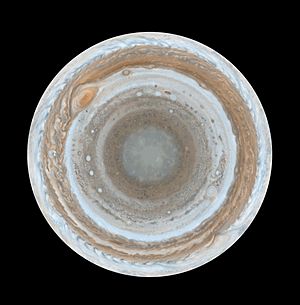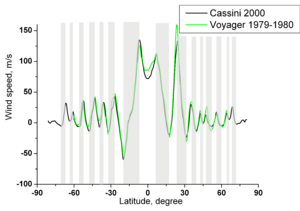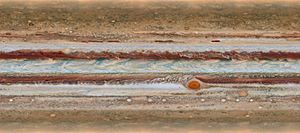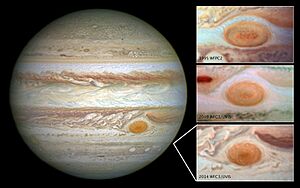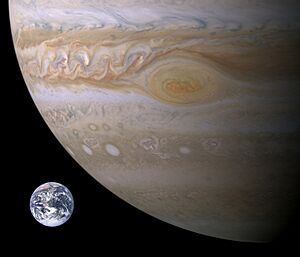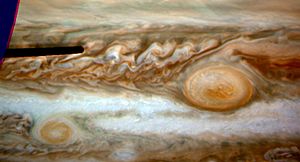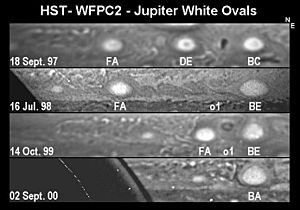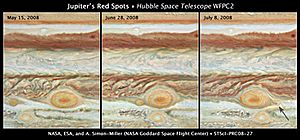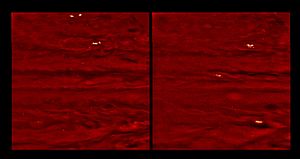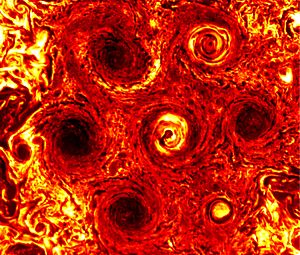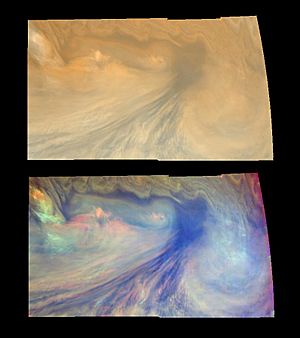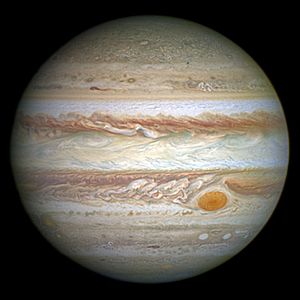Atmosphere of Jupiter facts for kids

Jupiter's atmosphere is the biggest planetary atmosphere in our Solar System. It's mostly made of molecular hydrogen and helium, just like the Sun. Other gases like methane, ammonia, hydrogen sulfide, and water are also present, but in smaller amounts. Scientists think there's a lot of water deep inside the atmosphere, but it's hard to measure directly.
Jupiter's atmosphere doesn't have a clear bottom. It slowly turns into the liquid inside the planet. From the lowest to the highest, the layers are the troposphere, stratosphere, thermosphere, and exosphere. Each layer has different temperatures. The lowest layer, the troposphere, has a complex system of clouds and hazes. These clouds are made of ammonia, ammonium hydrosulfide, and water.
The top ammonia clouds you can see on Jupiter are arranged in colorful bands. These bands run parallel to the equator. Strong winds called jets separate them. The bands switch colors: dark bands are called belts, and light ones are called zones. Zones are colder than belts. They are where gas rises up. Belts are where gas sinks down. The light color of zones comes from ammonia ice. Scientists aren't sure what makes the belts darker. We don't fully understand how these bands and jets form.
Jupiter's atmosphere is very active. It has unstable bands, swirling storms called vortices (like cyclones and anticyclones), and lightning. The vortices look like large red, white, or brown spots. The two biggest spots are the Great Red Spot (GRS) and Oval BA, which is also red. Most large spots are anticyclones, meaning they spin in the opposite direction of the planet's rotation. Smaller anticyclones are usually white. Scientists think these spots are not very deep, only a few hundred kilometers.
The GRS is in Jupiter's southern half. It's the biggest known storm in the Solar System. It's so huge that two or three Earths could fit inside it! This storm has been around for at least 300 years. Oval BA is south of the GRS. It's a red spot about one-third the size of the GRS. It formed in 2000 when three white spots merged together.
Jupiter has powerful storms, often with lightning. These storms happen when moist air rises, and water evaporates and then condenses. This creates bright, thick clouds. Storms mostly form in the belt regions. Jupiter's lightning strikes are hundreds of times stronger than Earth's. They are likely linked to the water clouds. Recent observations from the Juno spacecraft suggest Jupiter's lightning happens above the water clouds. A separation of electric charge between falling ammonia-water droplets and water ice particles might create lightning at higher altitudes. Lightning has also been seen very high up, about 260 kilometers above the 1 bar level (Jupiter's "surface").
Contents
How Jupiter's Atmosphere is Layered
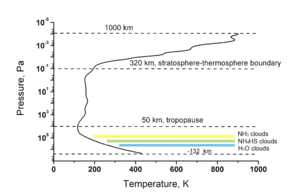
Jupiter's atmosphere has four main layers as you go higher up: the troposphere, stratosphere, thermosphere, and exosphere. Unlike Earth's atmosphere, Jupiter doesn't have a mesosphere. Jupiter also doesn't have a solid surface. The lowest layer, the troposphere, smoothly blends into the planet's liquid inside. This is because the temperatures and pressures are so high that there's no clear line between gas and liquid. Hydrogen acts like a special fluid called a supercritical fluid under these conditions.
Since the bottom of the atmosphere isn't clear, scientists often use the pressure level of 10 bars as the base of the troposphere. This is about 90 kilometers below the 1 bar "surface" of Jupiter, where the temperature is around 340 K. The 1 bar pressure level is usually chosen as the "surface" for measuring altitudes. The very top layer, the exosphere, doesn't have a specific upper edge. Its density just slowly decreases until it merges with the space between planets, about 5,000 kilometers above the "surface."
The temperature changes in Jupiter's atmosphere are similar to Earth's. In the troposphere, the temperature drops as you go higher. It reaches its lowest point at the tropopause, which is the border between the troposphere and stratosphere. On Jupiter, the tropopause is about 50 kilometers above the visible clouds (or the 1 bar level). The pressure there is about 0.1 bar, and the temperature is around 110 K. In the stratosphere, temperatures rise to about 200 K. This happens at the transition to the thermosphere, around 320 kilometers up. In the thermosphere, temperatures keep rising, reaching 1000 K at about 1000 kilometers up.
Jupiter's troposphere has a complex cloud system. The top clouds, between 0.6 and 0.9 bar pressure, are made of ammonia ice. Below these, there are likely denser clouds made of ammonium hydrosulfide (between 1 and 2 bar) and water (between 3 and 7 bar). There are no methane clouds because it's too warm for methane to condense. The water clouds are the thickest cloud layer and affect the atmosphere the most. This is because water has a high condensation heat and is more abundant than ammonia or hydrogen sulfide.
Above the main cloud layers, there are haze layers in the troposphere and stratosphere. The stratospheric haze layers are made from condensed heavy hydrocarbons or hydrazine. These form in the upper stratosphere from methane when exposed to the Sun's ultraviolet (UV) light.
Jupiter's thermosphere is where pressures are very low. Here, you can see phenomena like airglow, polar auroras, and X-ray emissions. Inside it are layers of increased electrons and ions that form the ionosphere. The high temperatures in the thermosphere (800–1000 K) are still a mystery. They might be caused by absorbing high-energy solar radiation, heating from charged particles from Jupiter's magnetosphere, or by waves moving upwards. The thermosphere and exosphere at the poles and low latitudes emit X-rays. Unlike Earth's auroras, which only appear during magnetic storms, Jupiter's auroras are always there.
What Jupiter's Atmosphere is Made Of
| Element | Sun | Jupiter/Sun |
| He/H | 0.0975 | 0.807 ± 0.02 |
| Ne/H | 1.23 × 10−4 | 0.10 ± 0.01 |
| Ar/H | 3.62 × 10−6 | 2.5 ± 0.5 |
| Kr/H | 1.61 × 10−9 | 2.7 ± 0.5 |
| Xe/H | 1.68 × 10−10 | 2.6 ± 0.5 |
| C/H | 3.62 × 10−4 | 2.9 ± 0.5 |
| N/H | 1.12 × 10−4 | 3.6 ± 0.5 (8 bar)
3.2 ± 1.4 (9–12 bar) |
| O/H | 8.51 × 10−4 | 0.033 ± 0.015 (12 bar)
0.19–0.58 (19 bar) |
| P/H | 3.73 × 10−7 | 0.82 |
| S/H | 1.62 × 10−5 | 2.5 ± 0.15 |
| Ratio | Sun | Jupiter |
| 13C/12C | 0.011 | 0.0108 ± 0.0005 |
| 15N/14N | <2.8 × 10−3 | 2.3 ± 0.3 × 10−3
(0.08–2.8 bar) |
| 36Ar/38Ar | 5.77 ± 0.08 | 5.6 ± 0.25 |
| 20Ne/22Ne | 13.81 ± 0.08 | 13 ± 2 |
| 3He/4He | 1.5 ± 0.3 × 10−4 | 1.66 ± 0.05 × 10−4 |
| D/H | 3.0 ± 0.17 × 10−5 | 2.25 ± 0.35 × 10−5 |
Jupiter's atmosphere has a similar mix of elements to the planet itself. We know a lot about it because the Galileo Probe flew right into it on December 7, 1995. Other spacecraft like Galileo and Cassini, plus telescopes on Earth, have also given us information.
The two main gases in Jupiter's atmosphere are molecular hydrogen (H2) and helium. The amount of helium is a bit lower than what was originally in the early Solar System. Scientists think some helium might have sunk into Jupiter's core, possibly as "helium rain." This could also explain why there's less neon, as it dissolves in helium droplets and would sink too.
The atmosphere also has simple compounds like water, methane (CH4), hydrogen sulfide (H2S), ammonia (NH3), and phosphine (PH3). Deep in the troposphere, these elements (carbon, nitrogen, sulfur, and possibly oxygen) are 2 to 4 times more common than in the Sun. Noble gases like argon, krypton, and xenon are also more abundant, but neon is scarcer.
Other rare gases like arsine (AsH3) and germane (GeH4) are found in tiny amounts. The upper atmosphere has small amounts of hydrocarbons like ethane and acetylene. These form from methane when hit by the Sun's UV light and charged particles from Jupiter's magnetosphere. Carbon dioxide, carbon monoxide, and water in the upper atmosphere likely come from comets hitting Jupiter, like comet Shoemaker-Levy 9.
Scientists have also studied the different types of atoms (isotopes) in Jupiter's atmosphere. The amount of deuterium (a type of hydrogen) is thought to be the original amount from when the Solar System formed. The ratio of nitrogen isotopes (15N to 14N) in Jupiter's atmosphere is lower than on Earth. This was a big discovery because scientists used to think Earth's ratio was the original one for the whole Solar System.
Jupiter's Bands, Belts, and Winds
Jupiter's visible surface is divided into several bands that run parallel to its equator. There are two types: light-colored zones and darker belts. The wide Equatorial Zone (EZ) is between about 7°S and 7°N latitude. Above and below the EZ are the North and South Equatorial belts (NEB and SEB). This pattern of alternating belts and zones continues up to the polar regions, where they become less clear.
The difference in how zones and belts look is due to how thick their clouds are. Zones have more ammonia, which creates thicker, higher clouds of ammonia ice, making them appear lighter. Belts have thinner clouds that are lower down. The upper troposphere is colder in zones and warmer in belts. We don't know the exact chemicals that give Jupiter's zones and bands their colors, but they might include complex compounds of sulfur, phosphorus, and carbon.
Jupiter's bands are shaped by strong winds called jets. Eastward-moving jets are found where zones meet belts (moving away from the equator). Westward-moving jets are where belts meet zones. These winds are very fast on Jupiter, over 100 meters per second (about 220 miles per hour). These speeds are found in the ammonia clouds. The eastward jets are usually stronger than the westward ones.
The Juno spacecraft has shown that these jets go thousands of kilometers deep into Jupiter. They extend parallel to Jupiter's spin axis, not towards the center of the planet. This matches a physics rule called the Taylor-Proudman theorem. The Galileo Probe found that winds stay strong down to at least 22 bars of pressure, which is much deeper than the clouds.
Why Jupiter has these colorful bands isn't fully clear. One simple idea is that zones are where air rises, and belts are where air sinks. When ammonia-rich air rises in zones, it expands and cools, forming high, dense white clouds. In belts, the air sinks and warms up, causing the white ammonia clouds to disappear. This reveals lower, darker clouds. The location and width of the bands, and the speed of the jets, are very stable. They have changed only a little between 1980 and 2000. However, the colors and brightness of the bands do change over time.
Specific Bands and Features
Each belt and zone on Jupiter has its own name and features. The North and South Polar Regions are usually bluish-gray and don't show much detail.
The North North Temperate Belt (NNTB) is the northernmost distinct belt, but it sometimes disappears. The North Temperate Region has the strongest eastward jet stream on the planet. The North Temperate Belt (NTB) sometimes fades, making the North Temperate Zone (NTZ) seem to merge with the North Tropical Zone (NTropZ).
The North Tropical Region includes the NTropZ and the North Equatorial Belt (NEB). The NTropZ usually keeps its color. Sometimes, it has "Little Red Spots," which are like smaller, short-lived versions of the Great Red Spot. The NEB is one of the most active belts. It has white ovals (anticyclones) and dark "barges" (cyclones). Like the South Equatorial Belt (SEB), the NEB has sometimes faded and then "revived."

The Equatorial Region (EZ) is one of the most stable areas. Its northern edge has amazing plumes that trail southwest from the NEB. These are bordered by dark, warm features called festoons (hot spots). The EZ changes color, from pale to orange or even coppery. Features in the EZ move very fast, about 390 km/h (240 mph) relative to other latitudes.
The South Tropical Region includes the South Equatorial Belt (SEB) and the South Tropical Zone. This is the most active region, home to Jupiter's strongest westward jet stream. The SEB is usually the widest, darkest belt. It can sometimes fade completely every 3 to 15 years, then reappear in what's called an SEB Revival cycle. After it disappears, a white spot forms and releases dark material, which Jupiter's winds stretch into a new belt. The SEB also has a long line of storms that follow the Great Red Spot. The STropZ is very prominent. It contains the GRS and sometimes has a long-lasting division called a South Tropical Disturbance (STropD).
The South Temperate Region, or South Temperate Belt (STB), is another dark, important belt. Until 2000, it was known for three long-lived white ovals (BC, DE, and FA) that later merged to form Oval BA ("Red Jr."). The STB has sometimes faded, possibly due to complex interactions with the white ovals and the GRS.
Other features on Jupiter are temporary or hard to see from Earth. Many zones and belts are not always visible. These include the Equatorial band (EB) and zones within the equatorial belts. Belts are also sometimes split by sudden disturbances.
Swirling Storms and Spots
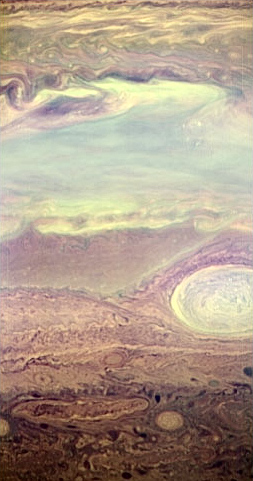
Jupiter's atmosphere has hundreds of vortices, which are circular spinning structures. Like on Earth, they are either cyclones or anticyclones. Cyclones spin in the same direction as the planet (counter-clockwise in the northern half, clockwise in the southern). Anticyclones spin the other way. On Jupiter, anticyclones are much more common than cyclones. Over 90% of vortices larger than 2000 km are anticyclones.
Jupiter's anticyclones are always found within the zones. They are usually bright and look like white ovals. They can move east or west, but they stay at roughly the same latitude. Winds around their edges are about 100 meters per second (220 mph). Different anticyclones in the same zone tend to merge when they get close.
Jupiter has two special anticyclones: the Great Red Spot (GRS) and Oval BA. Unlike the white ovals, these are red. This might be because they bring up red material from deeper inside the planet. Anticyclones on Jupiter usually form when smaller storms merge.
In contrast, Jupiter's cyclones are usually small, dark, and irregular. Some darker, more regular ones are called brown ovals. Cyclones are always found in the belts and tend to merge with each other. Scientists think vortices are relatively thin, not extending much deeper than about 500 kilometers.
The Great Red Spot
The Great Red Spot (GRS) is a huge, long-lasting anticyclonic storm. It's about 22° south of Jupiter's equator. People have been watching it for at least 350 years! It was first described as a "permanent spot" in 1665. It has been observed almost continuously since the 1870s.
The GRS spins counter-clockwise. One full spin takes about six Earth days. It measures 24,000–40,000 km (15,000–25,000 miles) from east to west and 12,000–14,000 km (7,500–8,700 miles) from north to south. It's big enough to fit two or three Earths inside! In 2004, the GRS was about half the size it was a century ago. It's still shrinking.
Infrared data shows that the GRS is colder and higher than most other clouds on Jupiter. Its cloud tops are about 8 km (5 miles) above the surrounding clouds. Winds around the edge of the spot can reach about 120 meters per second (270 mph). However, the air inside the spot seems to move very little. The GRS's color changes from brick-red to pale salmon, or even white. Scientists think the red color might come from complex organic molecules, red phosphorus, or sulfur compounds.
The GRS's latitude has stayed stable, but its longitude constantly changes. It has "lapped" the planet many times. Its drift rate changes and is linked to the brightness of the South Equatorial Belt.
In November 2014, data from NASA's Cassini mission suggested the red color is likely from simple chemicals broken apart by the Sun's ultraviolet light in Jupiter's upper atmosphere.
The Great Red Spot is different from the Great Dark Spot, which was seen near Jupiter's north pole by the Cassini–Huygens spacecraft in 2000. There was also a Great Dark Spot on Neptune, but it disappeared.
Oval BA
Oval BA is another red storm in Jupiter's southern half. It's like a smaller version of the Great Red Spot, often called "Red Spot Jr." or "Red Jr." It's in the South Temperate Belt. Oval BA was first seen in 2000 after three smaller white storms collided and merged. It has grown stronger since then.
The three white storms that formed Oval BA started in 1939. They merged in stages, with two merging in 1998, and then the third joining in March 2000 to form Oval BA.
Oval BA slowly started turning red in August 2005. By February 2006, it was the same shade as the GRS. Scientists aren't sure why Oval BA turned red. One idea is that strong winds pull certain gases from deeper in the atmosphere. These gases then change color when exposed to sunlight.
In 2007, observations from the Hubble Space Telescope showed that Oval BA was getting stronger. Its winds reached 618 km/h (384 mph), similar to the Great Red Spot. As of July 2008, Oval BA was about the size of Earth.
Oval BA should not be confused with another storm, the South Tropical Little Red Spot (nicknamed "the Baby Red Spot"). The GRS destroyed this smaller red spot in 2008.
Storms and Lightning
Jupiter's storms are like thunderstorms on Earth. They appear as bright, lumpy clouds, about 1000 km (620 miles) wide. They show up in the belts, especially where there are strong westward winds. Unlike the long-lived vortices, storms are short-lived. The strongest ones might last several months, but most only last 3–4 days. They are thought to be caused by moist air rising in Jupiter's troposphere. Storms are tall columns of air that bring wet air from deep inside to the upper troposphere, where it forms clouds. They can extend from about 5–7 bars pressure up to 0.2–0.5 bars.
Storms on Jupiter always have lightning. Spacecraft like Galileo and Cassini have seen regular flashes of light in Jupiter's belts. Jupiter's lightning strikes are much more powerful than Earth's. A few flashes have even been seen in the polar regions, making Jupiter the second planet after Earth to have polar lightning.
Every 15–17 years, Jupiter has especially powerful storms. These appear at 23°N latitude, where the strongest eastward jet is located. The last time this happened was in March–June 2007. Two storms appeared and greatly disturbed the northern temperate belt. They moved very fast, even faster than the jet itself, suggesting strong winds deep in the atmosphere.
Circumpolar Cyclones
Other interesting features near Jupiter's poles are its circumpolar cyclones (CPCs). The Juno Spacecraft has observed these. The northern pole has eight cyclones orbiting a central cyclone. The southern pole has five cyclones around a central one. These cyclones look like hurricanes on Earth, with spiral arms and a dense center.
Northern CPCs usually keep their shape and position better than southern CPCs. This might be because the southern winds are faster. Even with more movement, the southern CPCs tend to keep a pentagonal shape around the pole. The northern cyclones tend to maintain an octagonal structure.
Scientists believe these cyclones stay stable because of a balance of forces. Cyclones naturally move towards the poles, but the central polar cyclone pushes other cyclones away. This balance helps explain their fixed positions.
Mysterious Hot Spots
Some of the most mysterious features in Jupiter's atmosphere are hot spots. In these areas, the air has fewer clouds, allowing heat to escape from deeper inside the planet. They look like bright spots in infrared images. They are mostly found in the belts, but there's also a line of hot spots at the northern edge of the Equatorial Zone. The Galileo Probe actually flew into one of these equatorial spots. Each equatorial spot is linked to a bright, cloudy plume to its west, which can be up to 10,000 km (6,200 miles) in size. Hot spots are usually round, but they don't look like spinning vortices.
Scientists aren't sure how hot spots form. They could be areas where air is sinking, warming up as it goes down and becoming drier. Or, they might be a sign of planet-wide waves. The wave idea helps explain why the equatorial spots appear in a regular pattern.
Could There Be Life?
In 1953, the Miller-Urey experiment showed that lightning and certain chemicals (water, methane, ammonia, hydrogen) could create organic matter, like amino acids, which are building blocks of life. All these chemicals are found in Jupiter's atmosphere. Jupiter's atmosphere has strong vertical air currents that carry these compounds to lower regions. However, temperatures inside Jupiter get very high, which would break down these chemicals. This makes it hard for life similar to Earth's to form there. Scientists like Carl Sagan and Edwin E. Salpeter have thought about this.
How We've Studied Jupiter's Atmosphere
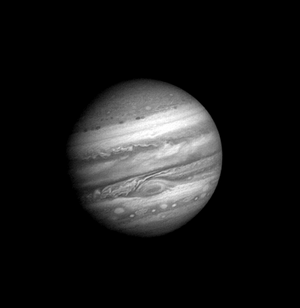
Early astronomers, using small telescopes, wrote down how Jupiter's atmosphere changed. Their descriptions—belts and zones, brown and red spots, plumes, and streamers—are still used today. Newer terms like "vorticity" and "cloud heights" came later.
The first close-up views of Jupiter's atmosphere came from the Pioneer 10 and 11 spacecraft. The Voyagers gave us the first truly detailed images, showing features as small as 5 km (3 miles). They even made "approach movies" of the atmosphere moving. The Galileo Probe gave us even better resolution and a wider range of data, even though it had an antenna problem.
Today, telescopes like the Hubble Space Telescope give us a continuous record of Jupiter's atmosphere. These show that while the atmosphere has huge disturbances sometimes, it's generally very stable. Scientists have also learned about the vertical movement of Jupiter's atmosphere by identifying trace gases. After Comet Shoemaker–Levy 9 crashed into Jupiter, spectroscopic studies gave us a peek at what's under the cloud tops.
The Galileo Probe plunged into Jupiter and measured wind, temperature, composition, clouds, and radiation levels down to 22 bars of pressure. However, what's below 1 bar in other parts of Jupiter is still uncertain.
Studying the Great Red Spot

Many people credit Robert Hooke with the first sighting of the GRS in May 1664. However, his spot might have been in a different belt. Giovanni Cassini's description of a "permanent spot" in 1665 is more convincing. Cassini's spot was seen until 1713, with some breaks in observation.
A painting from around 1700 by Donato Creti shows the GRS as red. No official description called a Jovian feature red before the late 19th century.
The current GRS was first seen after 1830 and studied well after 1879. There's a 118-year gap between the 17th-century observations and those after 1830. We don't know if the original spot disappeared and reformed, or if it just faded. The older spots were short-lived and moved slower, so they might not be the same as the modern GRS.
On February 25, 1979, the Voyager 1 spacecraft sent back the first detailed image of the Great Red Spot. It was 9.2 million kilometers (5.7 million miles) from Jupiter. Cloud details as small as 160 km (100 miles) were visible. The colorful, wavy clouds to the west of the GRS show very complex motions.
White Ovals
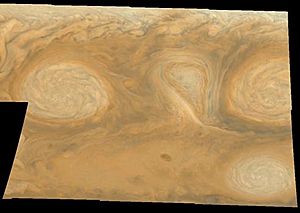
The white ovals that later became Oval BA formed in 1939. They were very long at first but quickly shrank. After 1965, their length became stable at 10 degrees or less. Even though they started as parts of the South Temperate Zone, they ended up completely inside the South Temperate Belt. This suggests they moved north and made a space for themselves in the belt. Like the GRS, their movements were controlled by two opposing jet streams.
The movement of these white ovals was affected by Jupiter's position in its orbit and how close they were to the GRS. They moved faster when Jupiter was farthest from the Sun and when they were within 50 degrees of the GRS. Overall, the white ovals slowed down over time.
During the Voyager fly-bys, the ovals were about 9000 km (5,600 miles) long and 5000 km (3,100 miles) wide. They rotated every five days.
See Also
 In Spanish: Atmósfera de Júpiter para niños
In Spanish: Atmósfera de Júpiter para niños
- Comet Shoemaker–Levy 9
- Extrasolar planet (many larger than Jupiter)
- Galileo Spacecraft (a mission that included both an orbiter and an atmospheric-entry probe)
- Juno probe
- 2009 Jupiter impact event
- 2010 Jupiter impact event
- Ulysses (spacecraft)
- Voyager 1, Voyager 2


